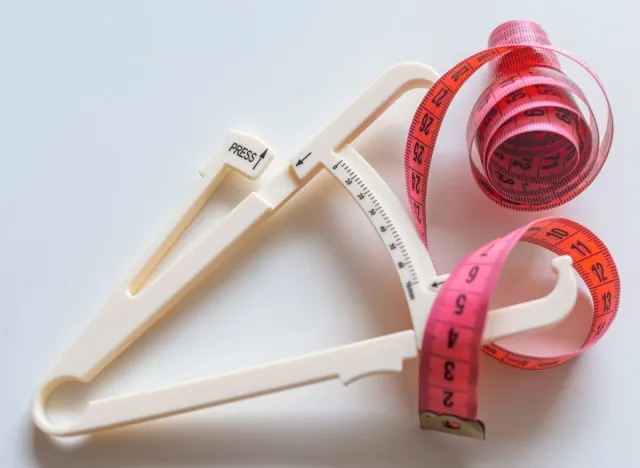When it comes to tracking weight loss and overall health, two metrics often come into play: body mass index (BMI) and body fat percentage. Both are frequently mentioned in fitness and health circles, but they measure different aspects of your body composition, which can lead to confusion about which is more important for your weight-loss goals. Understanding the difference between these two metrics can help you make more informed decisions about your health and fitness journey.
What is Body Mass Index (BMI)?

Body mass index (BMI) is a widely used method for categorizing individuals based on their weight in relation to their height. It was developed in the 19th century by Belgian mathematician Adolphe Quetelet and provides a quick snapshot of a person’s weight status, placing them into categories like underweight, normal weight, overweight, or obese.
To calculate BMI, you divide weight in kilograms (kg) by height in meters (m) squared. For imperial units, BMI is calculated by dividing weight in pounds (lb) by height in inches (in) squared and multiplying by a conversion factor of 703. (Tip: Many online calculators can help with this.)
For example, if you weigh 150 pounds and are 5 feet 6 inches tall, your BMI would be 24.2. A BMI of 24.2 would place you in the “normal weight” category according to standard BMI ranges:
- Underweight: < 18.5
- Normal weight: 18.5 – 24.9
- Overweight: 25 – 29.9
- Obese: ≥ 30
While BMI is easy to calculate and useful for a quick reference point, it doesn’t take into account the amount of weight that is from muscle versus fat mass. For that reason, someone can be considered obese when they, in fact, have an athletic, muscular build.
What Is Body Fat Percentage?


Body fat percentage refers to the proportion of your body weight that comes from fat. Unlike BMI, which doesn’t distinguish between fat and muscle, body fat percentage provides a more accurate picture of body composition, offering insights into how much of your body is composed of fat versus lean mass (like muscle, bones, and organs).
There are several methods to measure body fat percentage, ranging from simple to highly accurate:
- Skinfold Calipers: This method involves pinching the skin at various parts of the body and measuring the thickness of the skinfold. These measurements are then used to estimate overall body fat percentage.
- Bioelectrical Impedance Analysis (BIA): This method uses a small electrical current that passes through the body to estimate body fat. Because fat and muscle conduct electricity differently, the device can estimate the percentage of body fat.
- Dual-Energy X-ray Absorptiometry (DEXA): Often considered the “gold standard,” DEXA scans provide a detailed breakdown of body composition, including fat, muscle, and bone density.
- Hydrostatic Weighing: This method measures body density by comparing a person’s weight on land with their weight underwater. It’s highly accurate but not easily accessible for most people.
RELATED: Where Does Fat Actually Go When You Lose Weight?
Key Differences Between BMI and Body Fat Percentage


While both BMI and body fat percentage provide insights into your health, they do so in different ways:
- What They Measure: BMI is a simple calculation based on height and weight, while body fat percentage specifically measures the amount of fat relative to total body weight.
- Accuracy: BMI does not differentiate between fat and muscle, meaning a highly muscular person could be classified as overweight or obese. Body fat percentage, however, gives a more precise measurement of body composition.
- Individual vs. Population Use: BMI is more useful for population studies and screening, as it provides a quick way to assess potential health risks across large groups. Body fat percentage is more suited for individual assessments, especially when precise body composition is critical.
Why Body Fat Percentage Matters More for Weight Loss


When it comes to weight loss and overall health, body fat percentage is often a more meaningful metric than BMI. Here’s why.
- Targeting Fat Loss: Weight loss should ideally come from fat, not muscle. By focusing on body fat percentage, you can ensure that your efforts lead to fat loss, not just a lower number on the scale.
- Tracking Progress: Body fat percentage can give you a better sense of progress, especially if you also build muscle through exercise. Even if the scale doesn’t budge much, a reduction in body fat percentage means you’re getting leaner.
- Health Implications: A high body fat percentage is associated with a higher risk of health issues like heart disease, diabetes, and metabolic syndrome. Monitoring and reducing body fat percentage can lower these risks, even if your BMI is in the normal range.
In conclusion, while BMI can be a useful screening tool, it’s important to look beyond this number, especially if you’re serious about losing weight and improving your health. By focusing on reducing body fat percentage rather than just lowering your BMI, you can achieve more meaningful and long-lasting results in your weight-loss journey.
Gillean Barkyoumb, MS, RDN


